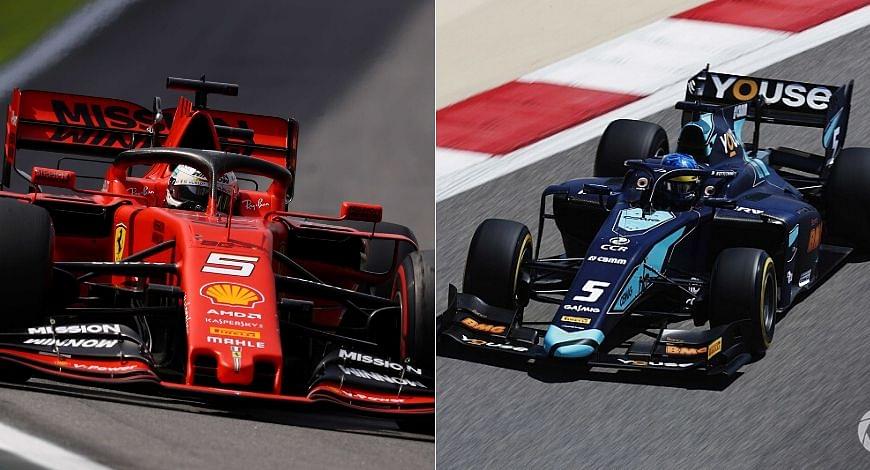Formula 1 is the apex of car racing with 20 drivers vying for the Championship title. But there is also Formula 2, where the future stars of F1 nourish themselves before they race for the big guns.
All the renowned racers in contemporary times raced in F2 before making it big in F1. Moreover, in the current lineup of F1, Charles Leclerc, Pierre Gasly, Lance Stroll, Alex Albon, and Max Verstappen were racing in F2 a few years ago.
Thus, F2 is a crucial stage before one makes his career in F1. But there aren’t many differences in both areas and functions on similar lines. Since it’s a stage for the development of the drivers, there are some fine exceptions.
What is the difference between F1 and F2
Cars
Unlike F1, every F2 driver sits in the car designed by Dallara. These cars are completely identical to each other and these drivers are backed by the same race engineers. This ensures that the talent is recognized instead of the victory of car specs.
All teams in F1 design their own chassis and aerodynamics. But as mentioned above about F2 cars, all the designs and specs are the same, so everyone got equal resources in the car.
Formula 2 also uses the newly inducted engine in the 2018- V6 engine. Still, the horsepower and turbo power are lower, which brings a difference in speed, which we will explain in the next section.
Speed
Since both F1 and F2 use the same engine, then what brings the difference in speed? Honestly, after the newly inducted rules, F2 cars have come very near to F1 cars in terms of speed.
In 2017, the gap between an F1 car and an F2 car was more than 10 seconds in Barcelona, which has reduced after both adopted V6 engines in 2018. But the real difference comes with F1 being allowed to design their cars. In F1, the teams can also make upgrades, chassis, and aerodynamics by themselves.
Unlike in F2, where all the cars are on the same level. Moreover, the horsepower in an F2 car hits a rpm of 10,000 while F1 cars reach 18,000 rpm. Thus, there is still a difference of some 20-30 km/h between F1 and F2.
Budget
The budget of an F2 team is just a fraction of what F1 teams spend. According to Forbes, “F1 outfits spend an average of $250 million annually whilst F2 team budgets come to around 2.5%.”
The report further states that drivers usually even pay a certain amount to race in F2. At the same time, this thing is comparatively irregular in F1, with drivers like Lance Stroll and Nicholas Latifi accused of being paid drivers.
The F1 budget caps 2022
While the earlier years’ quotation by Forbes mentions that an average F1 team has a budget of $250 million, before 2022, teams like Ferrari, Mercedes and Red Bull could stretch it to over $400 million.
But now, things are different with the new regulation of budget caps. In 2022, F1 finally introduced the rule of every team managing their operations under a budget.
This totally irked the big teams, who could muscle their way up by gaining an advantage by splashing money on development. But now, with every team equal in finances, the competition in the grid could enhance.
The 2022 budget for every F1 team should not surpass $142.4 million. And in 2023, it could further go down by five million more unless the inflation goes beyond 3%.
Teams like Alfa Romeo, which got massive sponsorship deals from China after signing Guanyu Zhou, are apparently touching the cost cap. Hence when it comes to finances, they’re at par with many top teams on the grid.
Whether it will reflect on the performances remains to be seen. But so far, the budget caps are a debatable topic, and it could get even more heated if the drivers’ salaries are included, which so far are not. But there are a few prominent members who are in favour.
Also read: Why Do F1 Cars Spark: Reason behind sparks flying off from back of an F1 car explained
Teams
Like F1 teams, even F2 teams have owners and teams, but the capital expenditure is less, and even the crew and staff are much less, unlike the F1 teams.
This year there are 11 teams in F2. Meanwhile, only 10 in Formula 1. Usually, the academies of F1 teams are instrumental in setting up an F2 side while placing their own driver from the academy.
Difference between F1 & F3?
While Formula 3 is not inferior to Formula 2 cars, it’s the pinnacle of junior Formula motorsport racing. Usually, drivers who participate in F2 promote themselves in it only after having a stint at F3. So what all intricacies do Formula 3 hold?
Cars: A F3 car is usually 550 kg heavy. These cars are capable of achieving 186.4 miles per hour. Though, their engines have only six years, including reverse. Moreover, the chassis design of all cars is the same.
Format: A F3 Grand Prix weekend consists of free practice on Friday, followed by qualifying. Though the top 12 drivers from qualifying have to go through reverse grid order, meaning the pole position driver in qualifying will start from P12 in the first race that happens on Saturday.
On Saturday, there are two races. The first race grid order is determined by qualifying with the reverse grid order implemented. However, the second race grid order is determined by the finish positions from the first race.
The third race happens on Sunday, with the grid order decided by the qualifying results in the correct order. That’s how a Formula 3 weekend happens. In 2023, F3 will have 10 rounds this year to declare a champion.
Points Distribution: The points distribution in F3 is received by the top 10 drivers in the race results. The points classification is same for all three races over the weekend.
| P1 | 15 points |
| P2 | 12 points |
| P3 | 10 points |
| P4 | 8 points |
| P5 | 6 points |
| P6 | 5 points |
| P7 | 4 points |
| P8 | 3 points |
| P9 | 2 points |
| P10 | 1 point |
| Fastest Lap | 2 points |







